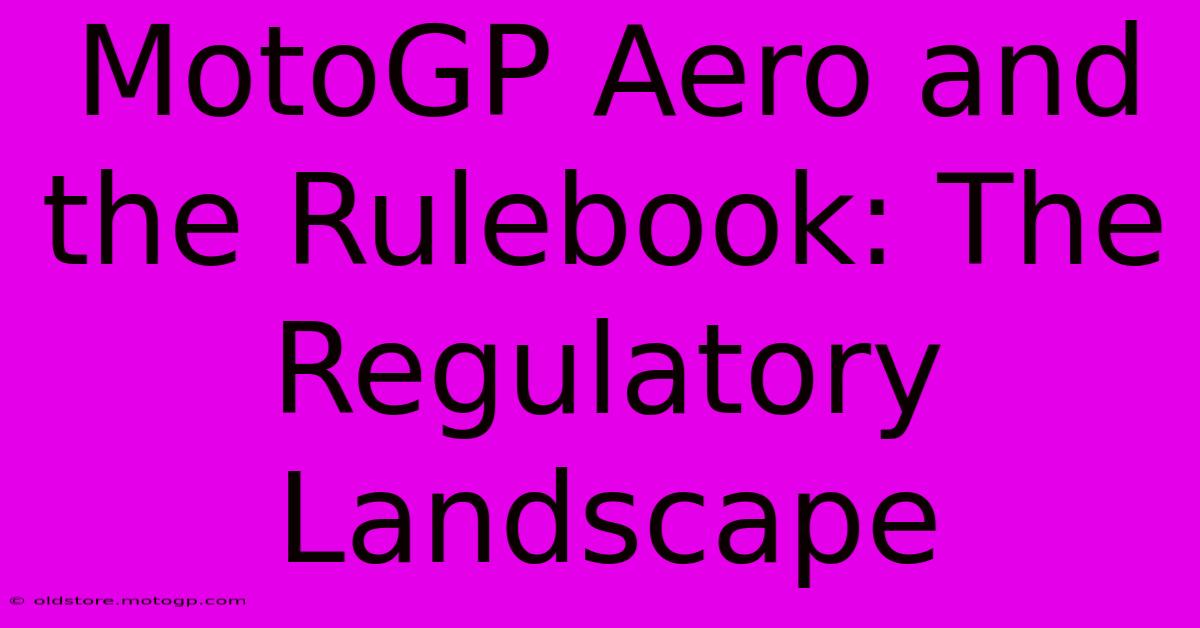MotoGP Aero And The Rulebook: The Regulatory Landscape

Table of Contents
MotoGP Aero and the Rulebook: The Regulatory Landscape
MotoGP, the pinnacle of motorcycle racing, is a constant battle of speed, skill, and technological innovation. Nowhere is this more apparent than in the development of aerodynamic packages. These intricate designs, carefully sculpted to minimize drag and maximize downforce, are crucial for lap times and rider safety. However, this technological arms race is tightly regulated by the MotoGP rulebook, creating a fascinating interplay between performance and control. This article delves into the complex regulatory landscape surrounding MotoGP aerodynamics.
The Importance of Aerodynamics in MotoGP
Aerodynamics play a pivotal role in MotoGP performance. Downforce, the force pushing the bike towards the track, enhances cornering speeds by increasing grip. Simultaneously, reducing drag, the resistance the bike encounters while moving through the air, improves straight-line speed. These factors combine to significantly impact lap times and overall race results. The constant pursuit of aerodynamic advantage fuels intense competition among manufacturers.
The Key Aerodynamic Components:
Several key components contribute to a MotoGP bike's aerodynamic performance:
- Fairings: The primary aerodynamic element, meticulously shaped to manage airflow around the bike.
- Wings: These are often seen attached to the front and rear of the motorcycle. They generate downforce, particularly crucial at high speeds.
- Winglets: Smaller aerodynamic appendages, often found on the fairing, further enhancing downforce and managing airflow.
- Underbody Aerodynamics: While less visible, the design of the underbody is crucial for optimizing airflow and generating downforce.
The MotoGP Rulebook and Aerodynamic Regulations:
The MotoGP rulebook imposes strict regulations on aerodynamic devices to ensure fair competition and rider safety. These rules are constantly evolving, reflecting both technological advancements and safety concerns.
Key Regulatory Aspects:
- Size and Dimensions: Strict limits are placed on the size and dimensions of aerodynamic components, preventing teams from creating excessively large or complex designs. This limits the potential aerodynamic advantage.
- Testing Restrictions: Wind tunnel testing is crucial for aerodynamic development, but the rulebook often restricts the amount of testing allowed to prevent one manufacturer from gaining an unfair edge.
- Material Specifications: Regulations specify allowed materials for aerodynamic components, ensuring consistency and safety.
- Safety Standards: Aerodynamic components must meet rigorous safety standards to prevent detachment during a crash.
The Evolving Landscape of MotoGP Aerodynamics:
The regulatory landscape surrounding MotoGP aerodynamics is not static. The rules are frequently updated to address new technological developments and ensure fair play. This dynamic interplay between innovation and regulation shapes the direction of aerodynamic development in the sport.
The Impact of Technological Advancements:
As technology advances, new aerodynamic solutions are constantly being explored. This leads to ongoing revisions in the rulebook, as governing bodies strive to maintain a balance between innovation and equitable competition.
The Role of Safety in Shaping Regulations:
Rider safety is paramount in MotoGP. The rules governing aerodynamics are heavily influenced by safety concerns. Regulations aim to minimize the risks associated with aerodynamic component failure.
Conclusion: A Delicate Balance
The regulatory landscape governing aerodynamics in MotoGP represents a delicate balance between technological innovation and fair competition. While manufacturers strive for maximum aerodynamic performance, the rulebook ensures a level playing field while prioritizing rider safety. The ongoing evolution of these regulations underscores the dynamic and ever-changing nature of MotoGP technology. The future will likely see further refinements and adjustments as manufacturers continue to push the boundaries of aerodynamic design. The intricate dance between rules and innovation is what keeps MotoGP so captivating and technically challenging, a constant push for that ultimate edge within the boundaries of the rulebook.

Thank you for visiting our website wich cover about MotoGP Aero And The Rulebook: The Regulatory Landscape. We hope the information provided has been useful to you. Feel free to contact us if you have any questions or need further assistance. See you next time and dont miss to bookmark.
Featured Posts
-
The Enduring Impact Of Moto Gp Commentary
Feb 20, 2025
-
Moto2 The Road To Victory
Feb 20, 2025
-
Moto Gp Sprint Races Edge Of Your Seat Entertainment
Feb 20, 2025
-
Best Motorcycle Racing A Beginners Handbook
Feb 20, 2025
-
Yamaha Moto Gp News What You Need To Know
Feb 20, 2025
